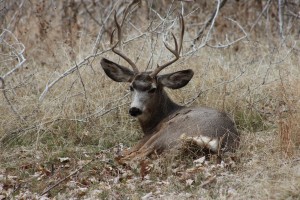By Michael Pearce
The Wichita Eagle
Chronic wasting disease, an illness that’s 100 percent fatal in deer and elk, has spread to six more counties in southwest Kansas, authorities say.
To date, the disease has never been passed to humans or livestock, though it is related to mad cow disease and some other illnesses that can be fatal to both.
Shane Hesting, wildlife disease coordinator with the Kansas Department of Wildlife, Parks and Tourism, said of about 600 deer tested, nine carried the disease. Most were shot by hunters during deer seasons.
Counties where new cases of the disease have been found are Gray, Hodgeman, Kearny, Pawnee, Meade and Scott, with one diseased deer each. Decatur, Norton and Rawlins counties in northwest Kansas each had one deer test positive from last fall’s samples. All three counties have had multiple deer test positive for chronic wasting disease in past years.

Mule Deer by http://jenniferajarrett.blogspot.com/2012/03/deer.html
Hesting said hunters who killed the animals are being notified of the results and, as a precaution, are being urged not to eat the venison. Areas where the disease has been found now stretch almost through western Kansas’ borders with Nebraska and Oklahoma. Biologists in Oklahoma have been notified the disease was found about 30 miles north of the state line.
Hesting said the six southwest Kansas deer that tested positive came from a test sample of 213 deer.
“It’s a small sample size, so the prevalence is probably higher than we expected in that part of the state,” said Hesting, who added that none of the 338 deer recently checked from south-central Kansas tested positive for chronic wasting disease.
He said the state focused its testing last fall on southwest and south-central Kansas. The three deer from northwest Kansas were tested because the hunters who killed them suspected the animals were ill because of actions or appearance.
Chronic wasting disease, a contagious neurological disease, was first discovered along the Wyoming-Colorado state line in the 1960s, affecting deer and elk. The disease spread slowly on its own but appears to have had some help as infected animals from game farms in that region were shipped across the country.
Chronic wasting disease has now shown up as far away as New York, southern New Mexico and parts of Saskatchewan in Canada.
It’s believed the disease is passed from animal to animal through things like saliva and feces, though it’s been known to contaminate an area for years in the soil. It is mostly contained in the central nervous system and bones of infected deer.
Some states no longer allow hunters to bring the complete skulls and bones of deer and elk they’ve shot from states with chronic wasting disease, like Kansas, into their home states. Hunters in many states are now advised to avoid contact with the brains and glands and to avoid cutting or breaking bones when they’re cleaning deer, elk or moose they’ve killed.
As the disease gradually spread into the Dakotas and Nebraska, Wildlife and Parks began testing deer in northwest Kansas for chronic wasting disease in 1996. The state’s first positive result in a wild deer occurred in 2005 in Cheyenne County, in extreme northwest Kansas. A captive elk transplanted from Colorado tested positive for the disease in Harper County in 2001.
Since 2005, 73 deer have tested positive in Kansas. Hesting said about 24,800 have been tested through the years.
Hesting said two of the bucks who tested positive were mule deer, of which only 51 were tested last fall. The rest were whitetails. All were bucks at least 3 1/2 years old when they were shot. All seven of the southwest Kansas bucks appeared healthy to the hunters and the technician who took the sample tissue or glands.
Lloyd Fox, Wildlife and Parks big game program coordinator, said initially most animals found with the disease in northwest Kansas appeared healthy. More and more are being found showing weakness, poor physical conditions or wandering aimlessly in that region because of the disease.
So far the disease hasn’t had much of an impact on the deer population in Kansas. Fox said that could change.
“The first few years, we see little impact, but most of us think it will, in decades, have to have a population effect as the environment becomes more contaminated,” he said. “When that happens, populations won’t jump back quickly from this. It’s a terrible disease.”

